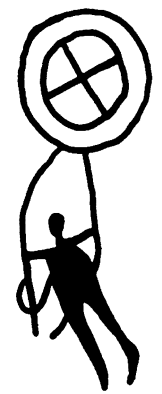Gender: Masculine
Planet: Sun
Element: Fire
Powers: Death, Healing, Perseverance, Protection, Psychic Powers, Strength
Planet: Sun
Element: Fire
Powers: Death, Healing, Perseverance, Protection, Psychic Powers, Strength
Magical Uses and History: Commonly known as Mountain Ash, Rowan has long been associated with witches, both as a tool of witches and as a defense against them. In order to fully understand where these properties arose from, we need to look no further than rowan's many names.
The name rowan is derived from the Scandinavian rauðr, meaning "red", and likely originates from Viking settlements in Scotland and northern England. This name refers to the bright red berries characteristic of rowan trees. Archaeological evidence suggests red was associated with protection and was often used in ceremonial burials, paintings, and even religious artifacts like the rosary. Furthermore, the berries feature a five-pointed star or pentagram, a well-known symbol of protection. The berries alone denote powerful protective properties, and as such, the berries and branches were often used in protection rites, rituals, and spells.
Rowan trees are often found near ancient burial sites, and are thought to provide protection against spirits of the dead. Rowan sprigs and berries were often worn or carried as protection, and even tied to livestock for the same purpose. Archaeological evidence suggests loops and crosses of rowan may have been hung in homes, especially above entryways, to protect against evil, negativity, and witches. In Celtic countries, rowan was commonly used to stir milk to protect it from curdling. There is even an old rhyme which states, "Rowan tree and red thread, Make the witches tine their speed." This suggests that rowan, in conjunction with the color red, protected against witches and would slow them down. They were so favored that it was frowned upon to cut down rowan trees, and removing one from your property was to invite bad luck. In many Celtic cultures, they were so revered that sprigs and berries could only be harvested using specific ritual tools and ceremony. In Norse mythology, it is the rowan that saves Thor from a fast-flowing river. All of these myths, folklore, and uses confirm that rowan is a powerful protector and can be used in rituals and spells for that purpose. Carry rowan on your person or in your car to ensure safe passage. Hang above doors and windows to prevent unwanted entries and negativity from entering your home. Use in spells and rituals to protect against curses or even break them, or prevent another witch from finding you. Include the berries and leaves in protection bags and spell jars. I have added 3 rowan berries to my hedge riding sachet to keep me safe while traveling to the Otherworld. Its uses in protection magic are truly endless.
Outside of Celtic countries, the rowan was also highly favored for its magical properties. In Greek mythology, Hebe, the goddess of youth, had her magical chalice stolen. The gods sent an eagle to retrieve it, and in the process, it was injured. Wherever its blood was spilled, rowan trees arose, which is said to explain its feather-like leaves and red berries. As such, the rowan is associated with blood, strength, and perseverance, and therefore can be used in spells and rituals for the same purpose.
In many countries, particularly in Scandinavia, the rowan is known as mountain ash because it commonly grows in craggy areas and in the most unlikely of places. It thrives in a wide range of zones, from 3-7, surviving the harshest of climates. As such, the rowan is associated with perseverance and strength. This makes rowan the perfect addition to spells requiring perseverance, allowing it to last longer and under harsher conditions than the spell normally would. The berries, leaves, and bark can strengthen the spell and ensure the best outcome while simultaneously protecting against backlash.
Finally, rowan is often associated with psychic powers and divination. This most likely arises from its use in making rune staves among the Norse. Use rowan branches to create your own runes or add the leaves to divination incense to increase your psychic awareness. It also makes the perfect incense to use during hedge riding or other astral travel.
There is so much folklore surrounding rowan that it is impossible to include it all here. I highly recommend checking out the many resources detailing its uses across multiple cultures to add to the information found here.
Rowan can be used in a number of spells, including:
Protection Spells
Strength Spells
Divination
Medicinal Uses: Wild rowan berries contain parascorbic acid, making them mildly toxic when consumed raw. In high enough quantities, especially in children, consumption can result in death. Their toxicity, however, is why rowan berries were often used as a laxative, as they induce diarrhea and vomiting. Modern varieties of rowan, however, have been bred to be more edible, and heating wild rowan berries turns parascorbic acid into sorbic acid, rendering it harmless. In folk medicine, rowan berries were commonly used to treat gout, digestive issues, menstrual cramps, and kidney disease. However, there is no current research to support these uses, and in many cases, wrongfully prepared berries can result in furthering these diseases. If you plan to use rowan berries in your herbal medicine practice, I highly recommend consulting with a licensed herbalist first.
Preparation and Dosage: To create a rowan berry infusion, combine 1 cup boiling water with 1 tablespoon dried rowan berries. Allow the mixture to infuse for 15 minutes. Drink up to three times a day. As a tincture, take 1 milliliter up to 3 times a day. Again, proceed with caution as rowan berries in high amounts can cause digestive upset, diarrhea, vomiting, kidney failure, and even death.

Want to print a copy of this for your Book of Shadows? Click below for your free copy!
If you liked this post, please consider leaving a small tip in the jar.

.png)









